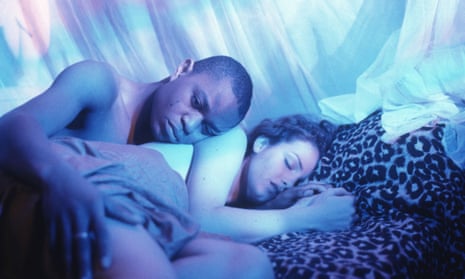Reissues and revivals are not uncommon in cinema, but it is not often that a film has the chance of a total critical makeover. That seems to be what is under way for Welcome II the Terrordome, a micro-budget dystopian sci-fi which, in 1995, became the first feature directed by a black British woman in UK cinemas.
“I call this my ‘angry film’,” says its director, Ngozi Onwurah, on the phone from Los Angeles, her gentle geordie accent unchanged by 12 years in the US. “Debates around race are meant to be measured and always have an entry point for white people; I’m not saying that’s wrong. I’m just saying I made it because I wasn’t in the mood for tempered debate.”
The significance of Onwurah’s milestone was emphasised by the fact that, up until Amma Asante’s 2004 debut A Way of Life, she remained the only black British woman to have directed a full-length feature film. Welcome II the Terrordome doesn’t mess about: after an opening scene that depicts a version of the Igbo Landing story, in which a group of 19th-century Africans drown themselves rather than submit to slavery, the narrative then jumps forward in time to a nightmarish segregated Britain where a black family, played by the same actors, struggle for dignity and survival. Alongside Young Soul Rebels (1991) and Babymother (1998), Welcome II the Terrordome was one of only three British features from the decade that centred on black characters.
Not that you would find much awareness of this context in media coverage from the time. The Daily Telegraph’s review called Welcome II the Terrordome “deplorable, both cinematically and in terms of its nihilistic view of the prospects for racial harmony”. Farrukh Dhondy, Channel 4’s then-multi-cultural commissioning editor, described it as “simply exploitative”. Perhaps most dismissive, though, was the Empire magazine review, which referred to Onwurah as a “he” throughout and chastised “him” for misreading the mood of race relations “in the more peaceable 90s” with a “would-be commercial movie”.

Earlier this month, Empire took the review offline, stating that “its content absolutely does not align with our values”. The film itself, meanwhile, is available to watch on BFI Player as part of We Are Parable’s Black British film season, and a Criterion re-release is in the works.
So is Welcome II the Terrordome in the process of a reappraisal? Dr Clive James Nwonka is a fellow in film studies at London School of Economics, the author of the forthcoming The Aesthetics of British Urban Cinema and the person who brought that 1995 review to Empire’s attention. He has doubts: “How is it possible to review a film with a clear pair of eyes, without thinking about the current moment?”
Certainly a lot has changed since 1995. There is (slightly) more diversity within British film criticism, and movements such as #MeToo and Black Lives Matter have, at least in theory, made everyone more aware of the intersecting oppressions faced by black women. Much of what seemed exaggerated or outrageous to critics 25 years ago – police brutality, the link between slavery and systemic racism – simply does not shock in the same way today.
“Actually, the anger I’ve started to feel in the last couple of months wasn’t dissimilar to the sort of anger I felt then,” says Onwurah. “My idea with Terrordome was to put all the things that were happening together in one night, to show what it would feel like if one thing happened straight after another and there wasn’t any calming down in between.” Now that social media provides us all with relentless images of black suffering and a comparably condensed timeline, that also seems prescient.
Terrordome’s depiction of politicised fury cut against the grain of New Labour-era multiculturalism, to the extent that critics were mostly unable to fully engage, says Nwonka. “I don’t think the film needs to be given a free pass in terms of ‘Is it a fantastic film?’ I don’t think it is. But the film had a particular intention that I think would be much more acceptable now.”
It was a film out of sync in other ways, too. Four Weddings and a Funeral had just been a huge international hit, firing up the British film industry’s commercial ambitions. “It can’t be a commercial film in the same way, because it has a different kind of politics,” says Nwonka. “[It’s this] normative desire for how black films should operate in this new 90s where, apparently, race has been consigned to the past.”
The film’s potentially negative impact on black British respectability was also a concern for a pre-eminent black academic, Paul Gilroy. Writing in Sight & Sound at the time, he feared “its incompetence will unleash the laughter of the world against black British cultural activists”. At least now the “special moral obligation” that Gilroy argued for black film-makers can be spread across more shoulders: Michaela Coel is the toast of 2020 and more new black film-making talent is coming through. “Now will they get the chance to make second, third and fourth feature films?” asks Nwonka. “In the way that other film-makers who are non-BME also do? Without the same scrutiny, the same struggles?”
That did not happen for Onwurah, although she did continue to make shorts and was about to go into production on a feature when the pandemic hit. Still, is there not a neat kind of poetic justice in her first feature, a time-travelling sci-fi, getting its own reincarnation? “Yeah, that is cool,” she says. “But it was the right reception at the time, because otherwise it wouldn’t have been doing what it was meant to do. People weren’t ‘there’ then.”
